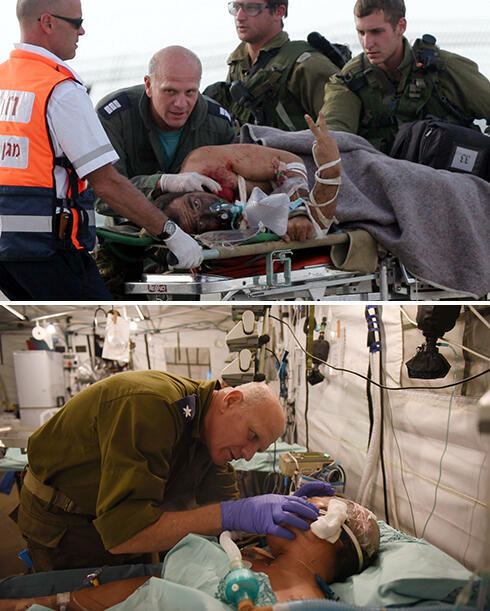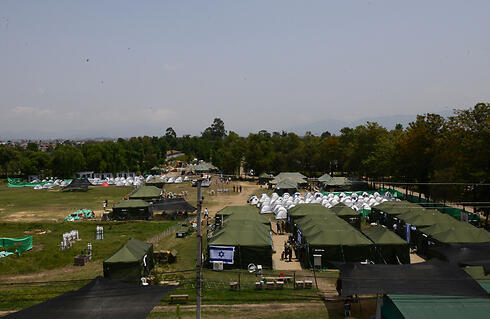His name may not be well known but the photo in which Dr. Adi Nimrod can be seen treating the wounds of Major Tomer Bohadana, who was seriously wounded during the Second Lebanon War, is etched into the Israeli psyche. Today, Dr. Nimrod is saving lives in Nepal at the IDF field hospital in the capital Kathmandu.
In the passages between tents at the hospital, Israeli and Jewish volunteers from around the world recognize the doctor whose photo became one of the prominent symbols of the Second Lebanon War. Dr. Nimrod flew to Nepal as director of an IDF Intensive Care Unit (ICU) and works around the clock, saving the lives of hundreds of Nepali patients, some of whom were seriously injured in the tragedy that claimed the lives of over 7,500 people.
3 View gallery


Top: The iconic photo of Dr. Nimrod during the Second Lebanon War. Bottom: The Dr. cars for patients in the wake of a devestating earthquake in Nepal. (Photo: IDF Spokesperson, Elad Gershgoren)
(צילום: דובר צה"ל, אלעד גרשגורן)
"There's been a lot of work over the last week," said Dr. Nimrod. "We have an amazing level of cooperation with the local hospitals in Kathmandu. We have serious and complicated patients. Some of them were injured in the earthquake and some of them underwent intricate orthopedic operations before coming to us for treatment because of the high quality of the hospital.
"We are three department heads who came especially from Israel. We left our families at home in order to save lives. There are lots of backpackers and volunteers who came to help us; it really warms the heart and increases everyone's motivation."
The military hospital in Kathmandu is already used to questions about the doctor in the ICU. "I recognized him immediately," said Hani who came to volunteer in the hospital during her vacation in Nepal. "I came up and asked him where I know him from. After talking with my friend, we saw his picture on the internet treating Tomer Bohadana who's making the 'V' symbol during the Second Lebanon War. It's inspiring. He's always in the difficult places where he has to save people's lives."
Dr. Nimrod is expected to return home with the rest of the Israeli team next week. The doctors and volunteers are overcoming the challenges of the situation they face through their ability to improvise and use the equipment that continues to arrive from Israel as needed.
"New patients are always arriving and so the tent designated as the emergency room was so full that the temperature reached up to 40 degrees Celsius," said Dr. Nimrod. "We started adding air conditioners until the temperature normalized. The department now adheres to the highest of standards and our patients receive life-saving treatment that embarrasses even hospitals that aren't in tents."
The earthquake that reached 7.8 on the Richter scale was the worst seen in Nepal for over 80 years. The death toll currently stands at over 7,500. More than 100 teams from abroad and some 131,000 Nepali soldiers are working to save lives and find the bodies of the deceased. With each passing day since the earthquake, the chances of finding survivors among the wreckage move closer to zero.
Meanwhile tens of thousands of people in the capitol of Kathmandu are still staying in public parks. Some lost their homes and others are afraid to return to their houses out of concern that an aftershock could strike and completely destroy what's left of the buildings.



